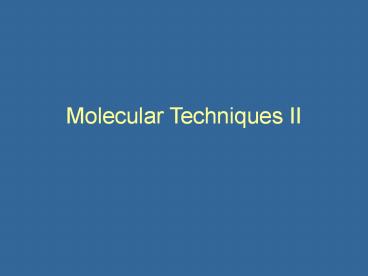Molecular Techniques II - PowerPoint PPT Presentation
Title:
Molecular Techniques II
Description:
... ELIZA only using Oligonucleotides rather than Antibodies Molecular Typing Techniques RFLP/AFLP AP/RAPD PCR TRFLP RFLP AFLP RAPD-PCR TRFLP Proteomic ... – PowerPoint PPT presentation
Number of Views:335
Avg rating:3.0/5.0
Title: Molecular Techniques II
1
Molecular Techniques II
2
Today
- Advanced PCR Techniques
- Other Amplification Technologies
- Primer/Probe Design
- Whole Genome/Transcriptome Amplification
- Post PCR Detection/Confirmation
- Molecular Typing Techniques
- Proteomic Techniques
3
Advanced PCR Techniques
- qPCR methods
- Solid phase PCR
- ICC-PCR
- Long-Template PCR
- Control of Product Carryover
4
qPCR Methods
- SyberGreen
- Minor Groove Binding Dyes
- Amplifluor Primers/LUX Primers
- FRET Technologies
- Taqman
- Molecular Beacons
- Hybridization Probes (HybProbes)
- Scorpion Primers
5
Syber Green and Minor Groove Dyes
- Double Stranded DNA Binding Dyes
- Once Bound Fluorescence Increases
- Simplest technology, works with any primer set
- Non-specific
- Requires melting curve analyses or subsequent
product analysis to confirm product
6
Melt Curve Analysis
7
Amplifluor and LUX Primers
8
Taqman Probes
9
Molecular Beacons
10
Hybridization Probes
11
Scorpion Primers
12
Solid Phase PCR
13
ICC-PCR
- Incorporates initial culture step into PCR
- More rapid than straight culture
- Better indication of infectivity than PCR alone
- Can alleviate some inhibition
14
Long-Template PCR
- Another strategy for overcoming limitation of PCR
to show viability - Amplifies much longer section of target genome
- Difficult to optimize problems with secondary
and tertiary structures - Less efficient
15
Control of Product Carryover
- Successful PCR can be your worst enemy
- Best control is structured work flow
- Other strategies
- UNG (uracil N-glycosylase)
- UV
16
Other Nucleic Acid Amplification Strategies
- NASBA
- Rolling Circle
17
NASBA
18
Rolling Circle
- phi-29 DNA Polymerase
- Random Hexamers
19
Primer and Probe Design
- For detection of organisms- Always a balance
between specificity and sensitivity - Dependent on target sequence and target structure
- Degenerate Primers
- Equimolar
- Universal base pairs
- Modifications
- Labels (fluorophores and biotin)
- Linkers
- Phosphorylation
- Modified bases (Universal, Ribobases, etc.)
20
Whole Genome Amplification
- Strand Displacement
- GenomePlex Approach
21
Multiple Strand Displacement
22
GenomePlex Approach
23
Post PCR Detection/Confirmation
- DNA Sequence Analysis
- Heteroduplex Mobility Assay
- Reverse Line Blot
- ELOSA
24
DNA Sequence Analysis
- Gold Standard
- Essentially Reading of Amplified Genetic Code
25
Heteroduplex Mobility Assay
26
Reverse Line Blot
27
Liquid Hybridization/ELOSA
- LH-Like Fluorescent Hybridization Assays, but
typically Chemiluminescent - ELOSA-Like ELIZA only using Oligonucleotides
rather than Antibodies
28
Molecular Typing Techniques
- RFLP/AFLP
- AP/RAPD PCR
- TRFLP
29
RFLP
30
AFLP
31
RAPD-PCR
32
TRFLP
33
Proteomic Techniques
- MALDI-TOF MS
- SELDI-TOF MS
34
MALDI-TOF MS
35
SELDI-TOF MS
36
Quantitation Considered
- Endpoint Dilution
- Quantal Assay/MPN
- Discrete Enumeration
- Fluorescent Detection
37
End-Point Dilution
- Serial dilution (typically 10-fold)
- Presence/Absence or Discrete Enumeration
- Can be applied to most methods
- Robust, but subject to pipetting errors
38
Quantal Assay/MPN
- Score each sample as /-
- Statistical estimation of titer
- Accuracy/Precision improves with increased
replication - Large confidence intervals
39
Discrete Enumeration
- Direct count of Colonies/Plaques
- Accuracy/precision improves with replication
- Limited by concentration in counted dilution
40
Fluorescent Detection
- Based on light emittance
- Luminometer
- Uses standard curves
- Indirect method (one more step to be inhibited)
41
Detection Methods Compared
- Strengths?
- Weaknesses?
- Sensitivities?
- Specificity?































